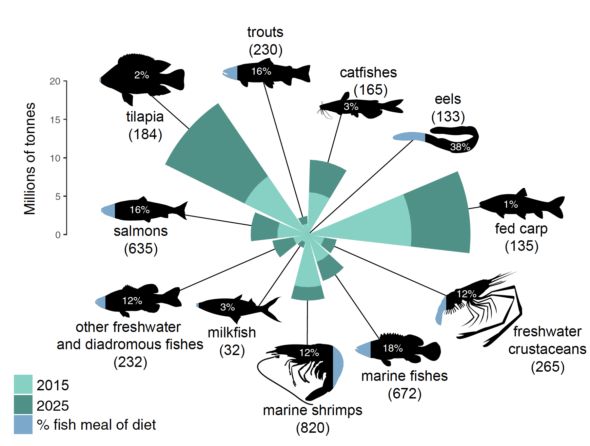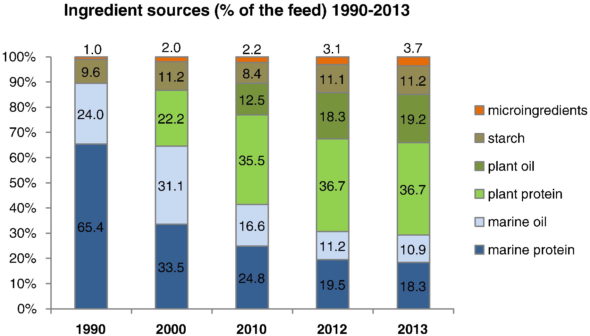Traditionally, the base raw materials for aquaculture feeds have been fishmeal and fish oil. Plant-based raw materials have replaced them in major amounts but specific means are needed to fulfill nutritional requirements of fish.
Growing global demand for aquafeeds
Aquaculture is one of the fastest growing animal food-producing sectors, the global growth exceeding human population growth. In contrast, the production of fishmeal and fish oil, the two traditional key elements in aquafeed formulation and fish nutrition, has either stagnated or declined during the last decades.
Consequently, there is an obvious gap between the limited availability of the two feed raw materials and the needs of a steadily growing aquaculture sector. Notably, the total production of aquafeeds for all aquaculture species is predicted to increase by 75% from 49.7 million tons in 2015 to 87.1 million tons in 2025 (Fig. 1).

Figure 1. The estimated aquafeed volume demand (millions of tons) of the major fed-aquaculture species groups in 2015 and 2025, and the use of fishmeal in the diet of each group in 2015 (represented by the blue portion of each animal). The values (percentage) inside each species group symbol are the estimated fishmeal inclusion in 2015. The values in brackets beside each species group symbol are the estimated volume of fishmeal included in the diets in 2015 (thousands of tons) (Source 1; Under Creative Commons license).
Need for alternatives to fishmeal and fish oil
Fishmeal and fish oil are of superior ingredients for fish nutrition. Because of their distinctive composition, few, if any, alternative raw materials match the nutritional value of fishmeal and fish oil (Infobox 1).
Fishmeal and fish oil originate from wild fish catches. Rather than increasing the harvest of wild fish stocks, the expansion of aquaculture has been accompanied by the search for alternative feed sources, also of terrestrial origin.
| Info box: Fishmeal and fish oils are of high quality ingredients for fish nutrition |
|
|
Fish nutrition is the key for developing novel feeds
The challenge for fish nutrition has been to design feeds based on a blend of novel alternative raw materials and a minimum or non-inclusion of fishmeal and fish oil, yet simultaneously fulfilling the specific nutritional requirements of the fish at a reasonable financial cost.
Different areas have to be considered to be successful on this.
- First, it is necessary to know what are the nutrients truly essential for each species and their ability to use them. Moreover, there are metabolic differences depending for example on the optimal growth temperature.
- Second, a detailed understanding of the nutrient composition and anti-nutritional factors of the alternative raw materials and their potential effect on the health of the animals is necessary. Some of the most common plant proteins like soybean meal or corn gluten meal contain a significant amount of non-starch polysaccharides with very little or no nutritional value.
- Third, it is necessary to know the processability of each raw material during the feed manufacturing.
- Fourth, alternative raw materials must be available in adequate volumes, and they need to be cost efficient and represent a sustainable advantage over the traditional fishmeal and fish oil.
The research efforts have allowed a reduction in marine raw materials, both fishmeal and oil, inclusion from more than 89% in 1990 down to around 29% in 2013 (Figure 1 and 2).

Figure 2. Raw material evolution in fish feed production in the last decades. A marked reduction of both fishmeal and fish oil use in aquafeeds is clearly seen (Source 2; Under a Creative Commons license).
AquaIMPACT: Superior genotypes need superior nutrition and feeding
The expected outcome of AquaIMPACT is to validate and demonstrate tailored feed formulations, supplements and feeding strategies specifically adapted for superior genotypes from breeding programs of four species: Atlantic salmon, rainbow trout, gilthead seabream and European seabass, to specifically adapt a tailor feed formulae for selected genotypes.
Within this main objective, an additional specific objective is to find potential ways to improve fish welfare by ensure that fish health and well-being are not compromised by the use of innovative feeds for selected genotypes, linking the use of tailored formulations to the robustness of the fish.
Authors:
Ramon Fontanillas, Grethe Rosenlund (Skretting Aquaculture Research Centre)
Daniel Montero, Silvia Torrecillas. (IU ECOAQUA- Universidad de Las Palmas de Gran Canaria, Spain).
References
1 Hua K et al. (2019). The Future of aquatic protein: Implications for protein sources in aquaculture diets. One Earth 1, DOI; 10.1016/j.oneear.2019.10.018.
2 Ytrestøyl T, Aas TS, Åsgård T. (2015). Utilisation of feed resources in production of Atlantic salmon (Salmo salar) in Norway. Aquaculture 448: 365-374. doi.org/10.1016/j.aquaculture.2015.06.023
